Improved gain and pattern behavior of these horns makes them ideal for use in other applications outside of EMC.
Vicente Rodriguez
ETS-Lindgren, Cedar Park, TX, USA
For over 40 years dual-ridged horn antennas have been the most common broadband horn used in EMC applications. These antennas are common in the EMC community in their 200-MHz to 2-GHz version and the 1-GHz to 18-GHz version. Recently a series of papers has appeared that show the limitations of these designs at the upper end of their respective bands. The present work shows the problems of these horns at the upper end of the band. Additionally, the paper reveals recent improvements to these horn antennas that eliminate these problems. The newly designed dual-ridged horn antennas are robust designs that have excellent behavior and performance across the entire band.
INTRODUCTION
Broadband antennas are the workhorse of field measurement. They allow the engineer and technician to measure different types of sources of electromagnetic radiation without having to stop the test to change the measuring antenna. There are several well known types of broadband antennas such as log periodic dipole arrays (LPDA) but these usually are limited in gain and their geometry makes them unsuitable to be used in certain chambers such as taper anechoic chambers [1]. In the case of EMC a very broad-banded LPDA needs to be extremely long to have high gain over a wide band. Which means that the phase center moves from the back of the antenna to the very front. For very long antennas these phase center movement can add errors to the emissions measurement. For immunity LPDAs have the problem that at the lowest frequency the radiating elements are much further away from the immunity plane, so usually more power is required to generate the required field. To reduce these problems typical LPDA antennas used in EMC are shorter and have a wider angle formed by the imaginary line that passes by the tips of the elements. The result is a LPDA with a lower gain, typically around 7dBi maximum. Ridged horns are another traditional broadband antenna. The most common design used in EMC date from 40 years ago. These horns are so widely accepted that have been even written into some EMC standards [2] as the proper antenna to be used. but in some cases the pattern behavior of these horns was far from desirable [3]. In this paper improvements to the dual ridge horn antennas are presented that show an improvement in both gain and radiation pattern.
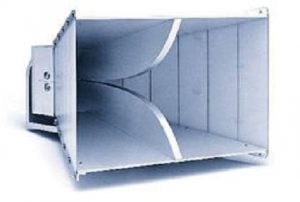
THE 1 GHZ TO 18 GHZ HORN


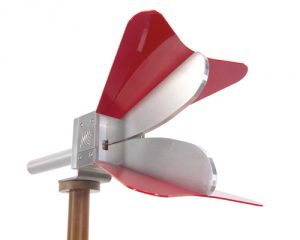
The dual-ridged horn antenna used in the 1GHz to 18GHz range is one of the most popular antennas in EMC for measurements both in emissions and immunity at frequencies above 1GHz (see Figure 1). As it was noted above this antenna is recommended by some standards as the proper antenna to be use. In 2003 C. Burns et al. in their paper [3] presented an analysis of the typical dual-ridge horn. The conclusions of the paper were that this type of horns had a pattern behavior that was not suitable for EMC use. Above 12GHz these horns, regardless of manufacturer, presented a pattern that split in to 4 or 5 different lobes. Figures 2 and 3 show the measured pattern of the traditional dual-ridged horn for the 1 to 18GHz range at 16 and 18GHz. This measured data shows the same pattern problems reported in [3]. To improve the horn performance a new 1 to 18GHz dual ridge horn design was presented in [1]. This new design, shown in Figure 4, corrected the pattern issues of the original dual-ridged design. Figures 5 and 6 show the measured pattern for the new horn design at 16 and 18GHz, showing that a single beam is preserved over the entire frequency range from 1 to 18GHz. The gain plots show that the new design has a very stable gain in the upper end, where the traditional dual-ridged horn presented large variations in gain caused by the pattern behavior. Figure 7 shows the gain behavior of these two horns. At 16GHz it would appear that the traditional design is superior to the new design. However, as it was shown in figure 2 the pattern has split into 5 different separate lobes. The central one is a very narrow lobe that causes the high gain. The antenna at this frequency is not suitable for immunity measurements, as it cannot create a uniform illumination over the immunity plane. At 18GHz the Traditional design gain is lower than that of the new design. Again figure 3 shows a notch on the center of the expected main radiation lobe and four lobes around this notch. Figure 6 shows that the notch and the four lobes do not exist on the new design and that a defined single lobe is present at 18GHz.


The new 1 to 18GHz horn is one of the latest breakthroughs in dual-ridges guide horn development. This horn provides a better radiation pattern and a more stable gain and antenna factor over the entire range of frequencies. With the new standards being developed, which concentrate on above 1GHz testing procedures, the knowledge of the pattern is going to be an important issue. While the traditional design was deemed unsuitable for EMC testing in [3] the new design has improved on all the issues. The new design is perfectly suitable for EMC testing over its entire range of operation.
THE 200 MHZ TO 2 GHZ HORN
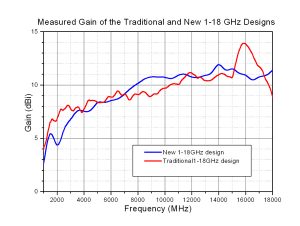
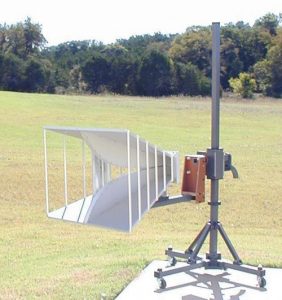
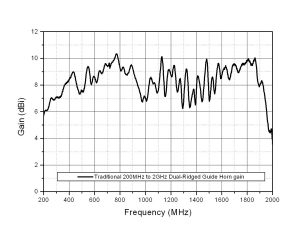
Another variant of the dual-ridged guide horn is the 200MHz to 2GHz model. Seen in Figure 8 this horn has a 10:1 bandwidth. As it was described in [3] the traditional 1-18Ghz horn starts having an ill-behaved pattern around 12GHz. So it is a superb antenna from 1GHz to 10GHz, a 10:1 bandwidth. It should be expected that the traditional 200MHz to 2GHz horn would be a very well behaved horn across its range of operation. Figure 9 shows the typical gain for the traditional 200MHz to 2GHz horn. From the gain plot it is clear that at about 1900MHz there is a drop in the gain. The drop in gain could be related to a mismatch and a high VSWR. A look of the VSWR shows that although there is an increase in VSWR at the high end this is not enough to account for the large drop in gain. A measurement of the pattern of the horn antenna shows that the drop in gain is related to a split of the pattern similar to the one seen on the 1-18GHz variant. Figure 10 shows the measured pattern of the traditional 200MHz to 2GHz horn. It is clear from figure 10 that a split has occurs and the main radiation lobe has broken into 4 separate lobes with a notch at the center. Measurements have shown that this split starts at 1900MHz.


MW Studio, a commercial package for EM modeling was used to study the problem. The Antenna was analyzed with the software. Figure 11 shows the feed cavity and the problem was located on the shape of the feed cavity. A modification of the feed cavity corrected the problem. Figure 12 shows the pattern of this newly improved dual-ridged guide horn for the 200MHz-2GHz range. This horn with the new improved gain at the top end of the antenna’s range of operation will be available soon for the EMC market. Figure 13 shows the gain improvement of the horn with the modified feed cavity at the high end of the range. The measured improvement at the high end is as high as 5dB of gain.

The feed cavity improvements used in the 200MHz to 2GHz dual-ridged guide horn antenna can be applied to similar antennas such as the 100MHz to 1GHz dual-ridged guide horn. This other variant of the dual-ridged guide horn antenna is especially useful in automotive EMC for full vehicle immunity measurements. Figure 14 shows the 100MHz to 1GHz version of the antenna.
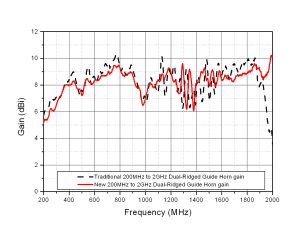
CONCLUSION

The dual-ridged guide horns have been a part of EMC testing for over thirty years. For most of this period this antennas have been used without a question. The publication of studies about these antennas in recent years, have brought to light some of the issues and the validity of their use in EMC. This paper has shown recent work done to improve the traditional designs making these antennas valuable tools in EMC. Additionally the improved gain and pattern behavior of these horns makes them ideal for use in ther applications outside of EMC.
REFERENCES
[1] L. H. Hemming, Electromagnetic Anechoic Chambers: A Fundamental Design and Specification Guide, IEEE Press: Piscataway, New Jersey, 2002.
[2] MIL-STD-461-E “Requirements for the Control of Electromagnetic Interference Characteristics of Subsystems and Equipment” Department Of Defense, August 1999.
[3] C.Burns, P. Leuchtmann, R. Vahldieck, “Analysis and Simulation of a 1-18GHz Broadband Double-Ridged Horn Antenna,” IEEE Trans. On Electromagnetic Compatibility, Vol 45, No1, pp 55-60, Feb 2003.
[4] V. Rodriguez, “New Broadband EMC Double-Ridge guide Horn Antenna,” RF Design, Vol 27, No 5, pp 44-50, May 2004.
Vicente Rodriguez-Pereyra attended the University of Mississippi where he obtained his B.S.E.E. in 1994 and his M.S. and Ph.D. in Engineering Science with emphasis on Electromagnetic Th eory in 1996 and 1999, respectively. In August 1999 Dr. Rodríguez joined the faculty of the Department of Electrical Engineering and Computer Science at Texas A&M University-Kingsville. In June 2000, Dr. Rodríguez joined EMC Test Systems (now ETS-Lindgren) as an RF and electromagnetics engineer. During this time he was involved in anechoic chamber design. In September 2004, Dr. Rodríguez took over the position of Senior Principal Antenna Design Engineer and took on the responsibility of developing new antennas and of improving existing models.
Dr. Rodríguez’s interests are Numerical Methods in Electromagnetics, especially when applied to antenna design and analysis. Dr. Rodríguez is the author of more than twenty publications including journal and conference papers as well as book chapters. Dr. Rodriguez holds patents for hybrid absorber design and for a new dual ridge horn antenna design for EMC applications. Dr. Rodríguez is a member of the IEEE and several of its technical societies. Dr. Rodríguez is an active member of the Applied Computational Electromagnetic Society (ACES). Dr. Rodriguez has served as a reviewer for the ACES Journal and for the Journal of Electromagnetic Waves and Applications. He has co-chaired sessions during the 2003 and 2006 ACES symposium and workshops during the 2002 and 2004 IEEE EMC annual symposiums. Dr. Rodríguez is a full member of the Sigma Xi Scientific Research Society and of the Eta Kappa Nu Honor Society.
